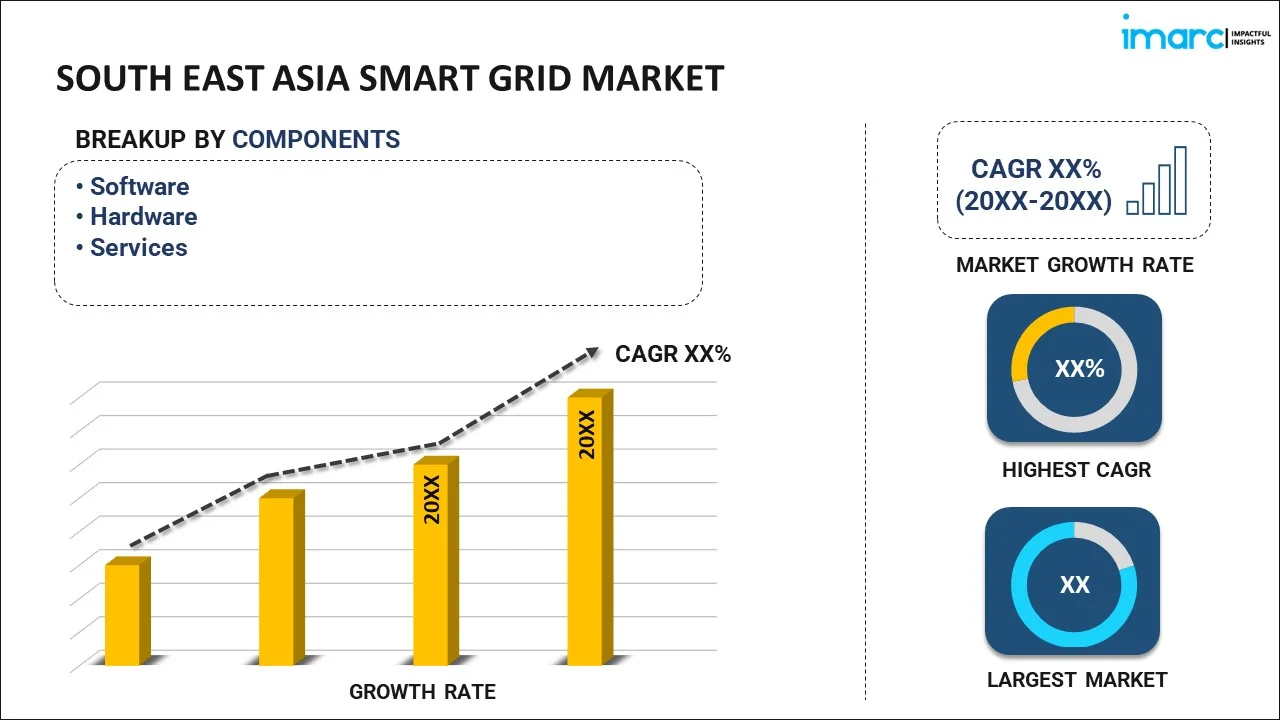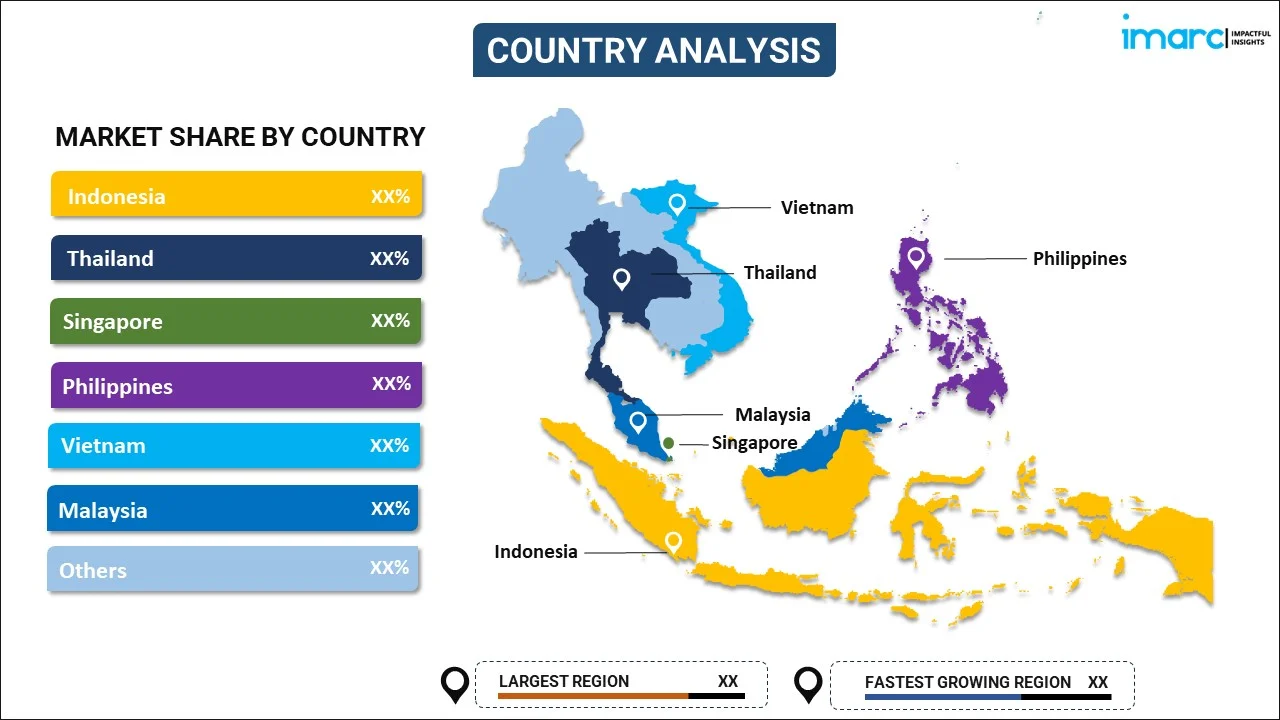
South East Asia Smart Grid Market Report by Component (Software, Hardware, Services), End User (Residential, Commercial, Industrial), and Country 2024-2032
Market Overview:
South East Asia smart grid market size is projected to exhibit a growth rate (CAGR) of 5.10% during 2024-2032. The deployment of smart meters, which enables real-time monitoring of energy consumption, provides accurate billing information, and encourages consumers to make informed decisions about their energy usage, is driving the market.
|
Report Attribute
|
Key Statistics
|
|---|---|
|
Base Year
|
2023 |
|
Forecast Years
|
2024-2032
|
|
Historical Years
|
2018-2023
|
| Market Growth Rate (2024-2032) | 5.10% |
A smart grid is an advanced electricity distribution system that utilizes modern communication, sensing, and control technologies to enhance the efficiency, reliability, and sustainability of electrical power delivery. Unlike traditional grids, smart grids enable bidirectional communication between utilities and consumers, allowing for real-time monitoring and control of energy consumption. They integrate renewable energy sources, energy storage, and electric vehicles into the grid seamlessly, optimizing the use of resources and reducing environmental impact. Smart grids enhance grid resilience by quickly identifying and isolating faults, along with minimizing downtime during outages. Additionally, they empower consumers with tools like smart meters and demand response programs, enabling them to make informed decisions about their energy usage. Overall, smart grids represent a paradigm shift in power infrastructure, fostering a more interconnected, adaptive, and environmentally conscious electricity distribution system.
South East Asia Smart Grid Market Trends:
The smart grid market in South East Asia is experiencing robust growth, driven by a confluence of factors. Firstly, the escalating regional demand for energy efficiency has propelled governments and utilities to invest in smart grid technologies. Additionally, the increasing integration of renewable energy sources necessitates advanced grid management, a need that smart grids adeptly fulfill. Moreover, the rising awareness and emphasis on environmental sustainability have prompted a paradigm shift towards smart grids, as they enable more efficient energy consumption and reduce carbon footprints. Furthermore, ongoing technological advancements, such as the Internet of Things (IoT) and artificial intelligence, have catalyzed the evolution of smart grids, making them more sophisticated and capable of real-time monitoring and optimization. Furthermore, the escalating frequency and severity of natural disasters underscore the resilience and reliability advantages offered by smart grids. Governments and utilities recognize the imperative of enhancing grid resilience to mitigate the impact of disasters, positioning smart grids as a crucial solution. In essence, the regional smart grid market is being propelled by a combination of energy efficiency imperatives, renewable energy integration, environmental consciousness, technological advancements, and the imperative for grid resilience in the face of increasing challenges.
South East Asia Smart Grid Market Segmentation:
IMARC Group provides an analysis of the key trends in each segment of the market, along with forecasts at the regional and country level for 2024-2032. Our report has categorized the market based on component and end user.
Component Insights:

- Software
- Advanced Metering Infrastructure
- Smart Grid Distribution Management
- Smart Grid Network Management
- Substation Automation
- Others
- Hardware
- Sensor
- Programmable Logic Controller
- AMI Meter
- Networking Hardware
- Others
- Services
- Consulting
- Support and Maintenance
- Deployment and Integration
The report has provided a detailed breakup and analysis of the market based on the component. This includes software (advanced metering infrastructure, smart grid distribution management, smart grid network management, substation automation, and others), hardware (sensor, programmable logic controller, AMI meter, networking hardware, and others), and services (consulting, support and maintenance, and deployment and integration).
End User Insights:
- Residential
- Commercial
- Industrial
A detailed breakup and analysis of the market based on the end user have also been provided in the report. This includes residential, commercial, and industrial.
Country Insights:

- Indonesia
- Thailand
- Singapore
- Philippines
- Vietnam
- Malaysia
- Others
The report has also provided a comprehensive analysis of all the major regional markets, which include Indonesia, Thailand, Singapore, Philippines, Vietnam, Malaysia, and Others.
Competitive Landscape:
The market research report has also provided a comprehensive analysis of the competitive landscape in the market. Competitive analysis such as market structure, key player positioning, top winning strategies, competitive dashboard, and company evaluation quadrant has been covered in the report. Also, detailed profiles of all major companies have been provided.
South East Asia Smart Grid Market Report Coverage:
| Report Features | Details |
|---|---|
| Base Year of the Analysis | 2023 |
| Historical Period | 2018-2023 |
| Forecast Period | 2024-2032 |
| Units | US$ Million |
| Scope of the Report | Exploration of Historical and Forecast Trends, Industry Catalysts and Challenges, Segment-Wise Historical and Predictive Market Assessment:
|
| Components Covered |
|
| End Users Covered | Residential, Commercial, Industrial |
| Countries Covered | Indonesia, Thailand, Singapore, Philippines, Vietnam, Malaysia, Others |
| Customization Scope | 10% Free Customization |
| Report Price and Purchase Option | Single User License: US$ 3699 Five User License: US$ 4699 Corporate License: US$ 5699 |
| Post-Sale Analyst Support | 10-12 Weeks |
| Delivery Format | PDF and Excel through Email (We can also provide the editable version of the report in PPT/Word format on special request) |
Key Questions Answered in This Report:
- How has the South East Asia smart grid market performed so far and how will it perform in the coming years?
- What has been the impact of COVID-19 on the South East Asia smart grid market?
- What is the breakup of the South East Asia smart grid market on the basis of component?
- What is the breakup of the South East Asia smart grid market on the basis of end user?
- What are the various stages in the value chain of the South East Asia smart grid market?
- What are the key driving factors and challenges in the South East Asia smart grid?
- What is the structure of the South East Asia smart grid market and who are the key players?
- What is the degree of competition in the South East Asia smart grid market?
Key Benefits for Stakeholders:
- IMARC’s industry report offers a comprehensive quantitative analysis of various market segments, historical and current market trends, market forecasts, and dynamics of the South East Asia smart grid market from 2018-2032.
- The research report provides the latest information on the market drivers, challenges, and opportunities in the South East Asia smart grid market.
- Porter's five forces analysis assist stakeholders in assessing the impact of new entrants, competitive rivalry, supplier power, buyer power, and the threat of substitution. It helps stakeholders to analyze the level of competition within the South East Asia smart grid industry and its attractiveness.
- Competitive landscape allows stakeholders to understand their competitive environment and provides an insight into the current positions of key players in the market.
Need more help?
- Speak to our experienced analysts for insights on the current market scenarios.
- Include additional segments and countries to customize the report as per your requirement.
- Gain an unparalleled competitive advantage in your domain by understanding how to utilize the report and positively impacting your operations and revenue.
- For further assistance, please connect with our analysts.
 Inquire Before Buying
Inquire Before Buying
 Speak to an Analyst
Speak to an Analyst
 Request Brochure
Request Brochure
 Request Customization
Request Customization




.webp)




.webp)












